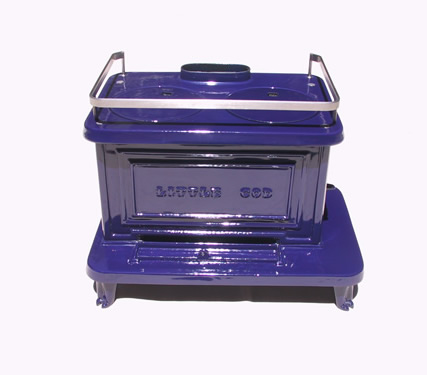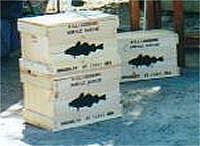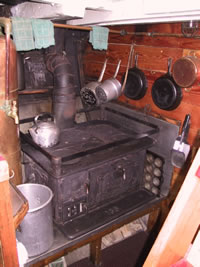* * *

click image above for more
By choosing the “Little Cod”, you will enjoy all the
benefits that only a traditional stove can deliver. Those
who own one say that they could not imagine cruising
without one!
Stoves made by Navigator have been carefully engineered
and hand-crafted to last a lifetime using only the finest
materials available. The stove’s porcelain enamel and
stainless steel fastenings will provide excellent service
within the demanding marine environment.
Due to its enduring practical appeal, the "Little Cod" has
earned a place aboard many craft on many coasts. First
produced circa 1917, this compact solid fuel stove was
initially designed to keep fishermen warm and well fed
as they jigged for cod. This ruggedly beautiful cast iron
marine stove is the result of over 80 years of refinement.
Its simplicity and reliability will be a welcome addition
to any galley, cabin, or pilothouse.
Economical to run and maintain, this source of dry heat will
undoubtedly be the greatest contributor to comfort aboard
your yacht. Designed for boats, but delightful in small rooms,
cabins, and workshops, the “Little Cod” will be ideal for spaces
where the use of a conventionally sized stove is impossible.
"Thank you, thank you, thank you for making this wood stove!
It is the coolest thing I've ever bought (aside from our boat).
It's heating the boat extremely well right now, and gives it a modern,
yet rustic vibe. I grew up with 2 wood stoves heating my house as a
kid and now the LC is making the boat feel just as homey.
My wife loves it, and we are a step closer to self sufficiency.
Thanks for all of your help. I'll send some pictures soon.
This thing ROCKS."
Sean S/V Sea Dancer, LI, NY.

Specifications:
Height:
11.375 In. (28.5 cm.)
to top of cook surface./13
In. (33 cm.) to top of sea rail.
Width: 18 In. (45.75 cm.). Depth: 13.75 In. (35 cm.) Weight: 50 Lbs. (22.5 kg.)
Features:
- Porcelain Enameled Cast Iron - The Ultimate in Beauty & Durability.
- Available in Black, Charcoal, Lt. Gray, Green, Blue, or Plain Iron.
- Stainless Steel "Sea Rail" (to keep cook pots in place).
- Stainless Steel Thru-Bolts & S.S Door Hinge Pins.
- Burns Wood & Hardwood Charcoal
-10,000 BTU's Low to 28,000 BTU's High, [ 3 - 8 Kw.] Heat Output.
- Right Hand Door Standard, Left Hand Optional.
- Diesel/Biodiesel Burner Retrofit Upcoming.
- Holes In Legs For Securing Stove To Floor.
- Uses 4" Chimney Pipe (10 Cm).
- Compatible with our upcoming "Drop-In" Alcohol/Propane Burner Modules!
- US EPA & State of Washington Emission Certification.
Modern "Clean-Burn" Technology - Non Catalytic.
When installing "on land" in Washington State,
Navigator's Outside Air Kit - #NSWOAK shall
be required. Call or Email for more info.
Pricing:
Width: 18 In. (45.75 cm.). Depth: 13.75 In. (35 cm.) Weight: 50 Lbs. (22.5 kg.)
Features:
- Porcelain Enameled Cast Iron - The Ultimate in Beauty & Durability.
- Available in Black, Charcoal, Lt. Gray, Green, Blue, or Plain Iron.
- Stainless Steel "Sea Rail" (to keep cook pots in place).
- Stainless Steel Thru-Bolts & S.S Door Hinge Pins.
- Burns Wood & Hardwood Charcoal
-10,000 BTU's Low to 28,000 BTU's High, [ 3 - 8 Kw.] Heat Output.
- Right Hand Door Standard, Left Hand Optional.
- Diesel/Biodiesel Burner Retrofit Upcoming.
- Holes In Legs For Securing Stove To Floor.
- Uses 4" Chimney Pipe (10 Cm).
- Compatible with our upcoming "Drop-In" Alcohol/Propane Burner Modules!
- US EPA & State of Washington Emission Certification.
Modern "Clean-Burn" Technology - Non Catalytic.
When installing "on land" in Washington State,
Navigator's Outside Air Kit - #NSWOAK shall
be required. Call or Email for more info.
Pricing:


